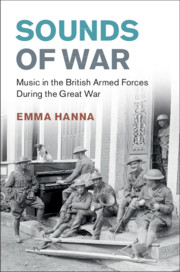Refine search
Actions for selected content:
15418 results in Military history
Figures
-
- Book:
- Sounds of War
- Published online:
- 20 February 2020
- Print publication:
- 05 March 2020, pp viii-ix
-
- Chapter
- Export citation
7 - Medicine and Therapy
-
- Book:
- Sounds of War
- Published online:
- 20 February 2020
- Print publication:
- 05 March 2020, pp 142-162
-
- Chapter
- Export citation
Abbreviations
-
- Book:
- Sounds of War
- Published online:
- 20 February 2020
- Print publication:
- 05 March 2020, pp xii-xiv
-
- Chapter
- Export citation
3 - Instruments of War
-
- Book:
- Sounds of War
- Published online:
- 20 February 2020
- Print publication:
- 05 March 2020, pp 53-75
-
- Chapter
- Export citation

Witness between Languages
- The Translation of Holocaust Testimonies in Context
-
- Published by:
- Boydell & Brewer
- Published online:
- 28 February 2020
- Print publication:
- 15 April 2018

Sounds of War
- Music in the British Armed Forces during the Great War
-
- Published online:
- 20 February 2020
- Print publication:
- 05 March 2020
Contents
-
- Book:
- Expertise, Authority and Control
- Published online:
- 10 February 2020
- Print publication:
- 11 February 2020, pp v-v
-
- Chapter
- Export citation
Chapter 1 - Gallipoli
-
- Book:
- Expertise, Authority and Control
- Published online:
- 10 February 2020
- Print publication:
- 11 February 2020, pp 19-48
-
- Chapter
- Export citation
Index
-
- Book:
- Expertise, Authority and Control
- Published online:
- 10 February 2020
- Print publication:
- 11 February 2020, pp 214-220
-
- Chapter
- Export citation
Chapter 5 - The most difficult problem
-
- Book:
- Expertise, Authority and Control
- Published online:
- 10 February 2020
- Print publication:
- 11 February 2020, pp 141-178
-
- Chapter
- Export citation
Chapter 2 - Medicine in the lines
-
- Book:
- Expertise, Authority and Control
- Published online:
- 10 February 2020
- Print publication:
- 11 February 2020, pp 49-79
-
- Chapter
- Export citation
Abbreviations
-
- Book:
- Expertise, Authority and Control
- Published online:
- 10 February 2020
- Print publication:
- 11 February 2020, pp xv-xviii
-
- Chapter
- Export citation
Copyright page
-
- Book:
- Expertise, Authority and Control
- Published online:
- 10 February 2020
- Print publication:
- 11 February 2020, pp iv-iv
-
- Chapter
- Export citation
Conclusion
-
- Book:
- Expertise, Authority and Control
- Published online:
- 10 February 2020
- Print publication:
- 11 February 2020, pp 179-187
-
- Chapter
- Export citation
Preface
-
- Book:
- Expertise, Authority and Control
- Published online:
- 10 February 2020
- Print publication:
- 11 February 2020, pp ix-x
-
- Chapter
- Export citation
Chapter 4 - A pleasant dose of medicine?
-
- Book:
- Expertise, Authority and Control
- Published online:
- 10 February 2020
- Print publication:
- 11 February 2020, pp 109-140
-
- Chapter
- Export citation
Note on style
-
- Book:
- Expertise, Authority and Control
- Published online:
- 10 February 2020
- Print publication:
- 11 February 2020, pp xiv-xiv
-
- Chapter
- Export citation
Figures, maps and tables
-
- Book:
- Expertise, Authority and Control
- Published online:
- 10 February 2020
- Print publication:
- 11 February 2020, pp vi-viii
-
- Chapter
- Export citation
Notes
-
- Book:
- Expertise, Authority and Control
- Published online:
- 10 February 2020
- Print publication:
- 11 February 2020, pp 188-206
-
- Chapter
- Export citation
Acknowledgements
-
- Book:
- Expertise, Authority and Control
- Published online:
- 10 February 2020
- Print publication:
- 11 February 2020, pp xi-xiii
-
- Chapter
- Export citation
